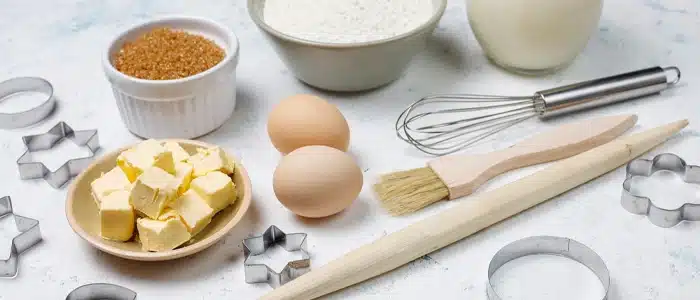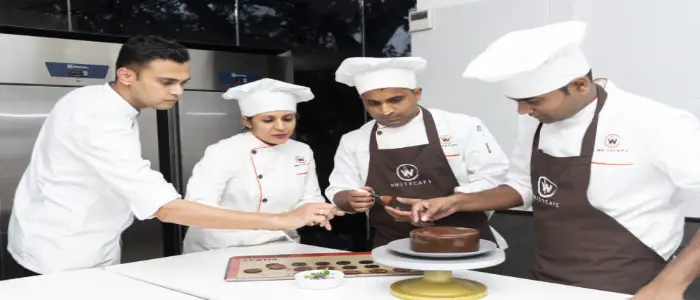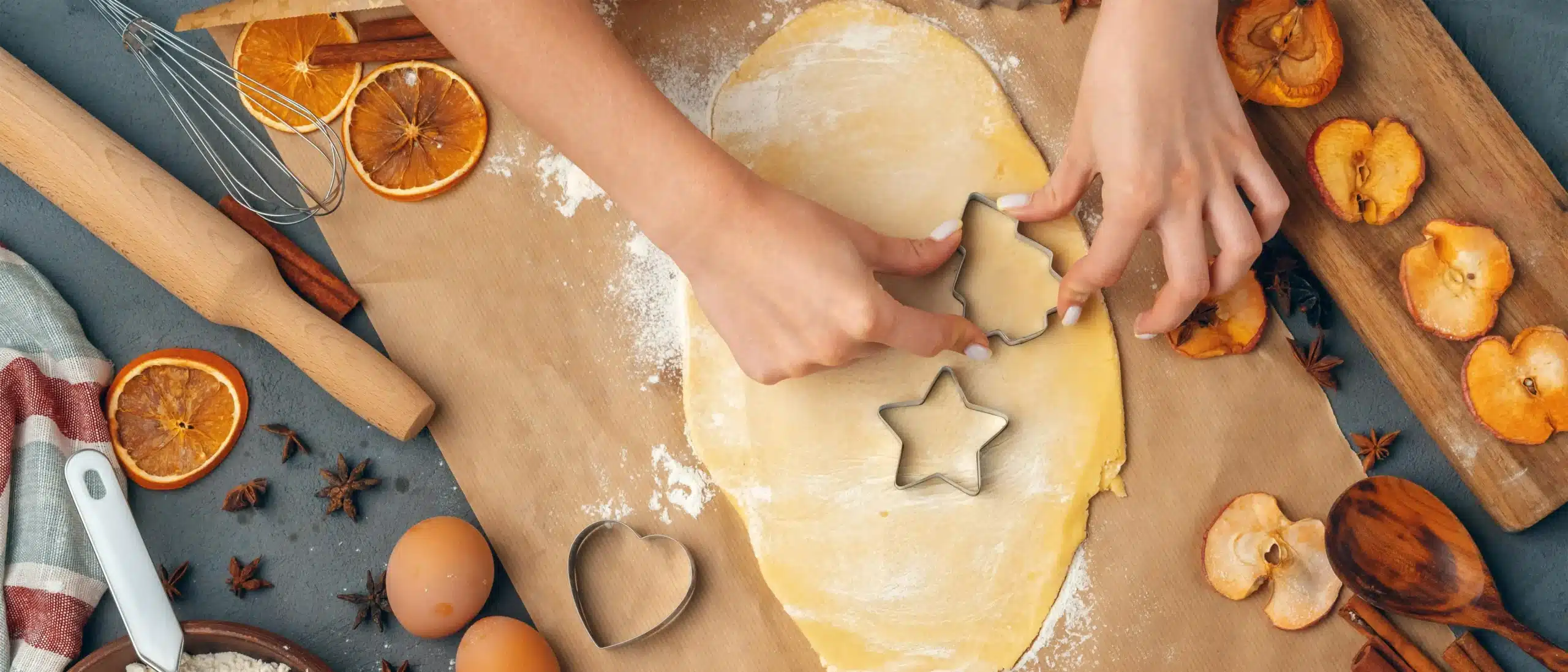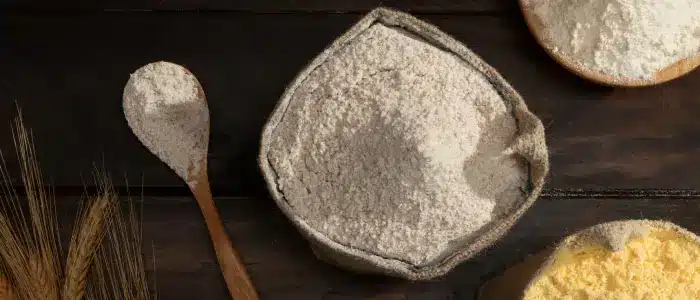Have you ever found yourself wondering what ingredients you should keep ready in your kitchen as a baker? Well, whether you’re an experienced baker or new to the kitchen, having a well-stocked pantry with the right baking essentials is crucial for achieving delicious treats.
This guide focuses on the essential baking ingredients, every home baker should have ready, for antwy recipe. From simple cakes to intricate pastries, we will cover all the key ingredients needed to elevate your baking game.
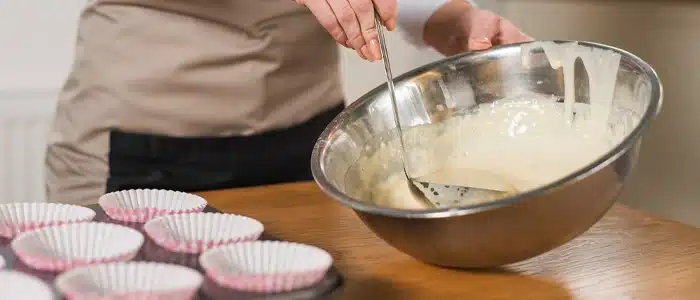
1. Flour- The foundation of Baking
Flour, a fine powder made from grinding grains, wheat, nuts, or other edible seeds, is an essential baking ingredient every baker should possess. Flour is the primary source of your baked goods’ structure, texture, and volume. As any baker will tell you, having top-notch flour is essential for delicious baked goods. Each recipe calls for a specific type of flour, depending on what you’re baking. So it’s a good idea to keep a variety of flours in your pantry to be ready for any baking journey that comes your way!
All-purpose flour
This is the most commonly used baking ingredient for cakes, cookies, muffins, and bread. Made from a blend of soft and hard wheat, its moderate protein content provides a balanced structure without being too dense.
Cake flour
Delicate baked goods demand cake flour. It contains less protein than all-purpose flour, resulting in a finer texture and a softer crumb, making it ideal for light and fluffy cakes.
Bread flour
Bread flour has a higher protein content, which is necessary for developing the gluten structure required for chewy, well-risen bread. This high gluten content is quintessential for the dough’s strength and elasticity, to make bread rise and get a nice texture.
Whole wheat flour
Whole wheat flour is the perfect choice for those who want to bake healthy. It contains the entire grain kernel, resulting in a nuttier flavor and denser texture that is ideal for hearty bread and muffins.
Pastry flour
Pastry flour, which has a protein content somewhere between cake flour and all-purpose flour, is commonly used in tender pastries and pie crusts that require a balance of flakiness and structure.
Gluten-free flour
If you are looking for alternatives to gluten-free flour, flours like buckwheat, almond, or cassava can satisfy your demand.
Knowing the properties of different types of flour and using them correctly according to the recipe requirements can result in the perfect texture and flavor of your baked goods.
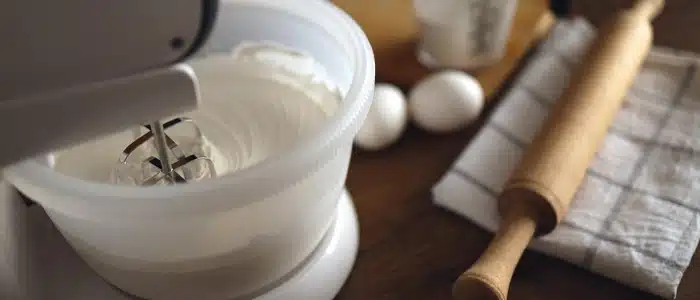
2. Leavening Agents- The only reason of your fluffy bake
Leavening agents are the second most important baking ingredient to have in your kitchen. Leavening agents are of 2 main types- baking soda & baking powder. Leavening agents are essential for producing light and airy textures in baked goods. They produce gas, which causes dough or batter to rise.
Baking Soda
Baking soda can transform your baked goods! It’s just one ingredient – sodium bicarbonate, a base. When it meets acid, it lets out carbon dioxide, making your treats rise beautifully. But be careful – too much baking soda can make your desserts taste bitter, and too little can leave them flat and dense. Remember, baking soda is there to balance out the acidity in your recipes and give you that perfect, soft crumb every time.
Baking Powder
Did you know that baking powder is a super handy ingredient to have in your kitchen? It’s a mix of baking soda, an acid (like cream of tartar), and a drying agent (like cornstarch). When you mix these all together, they create heat and gas, which helps your baked goods rise! So, basically, baking powder has all the magic it needs to make your treats fluffy and delicious.
Yeast
Yeast is a natural rising agent that works at a slower pace compared to chemical leaveners. This is because yeast cells need time to metabolize and produce carbon dioxide. As a result, home bakers can keep active dry yeast or instant yeast in their pantry for several months without any issues. Happy baking!
Sourdough starters
Did you know that sourdough starters are live yeast colonies that make sourdough bread taste so delicious? What’s even more fascinating is that you can keep the same sourdough starter alive forever! Just remember to use some of it and feed the rest to keep it thriving and replenishing itself.
Cake or Compressed Yeast
Did you know that cake, or compressed yeast, is actually alive? It means that it can produce more leavening gas compared to dry or instant yeast, which is pretty cool! However, because it’s alive, it’s also highly perishable. If you want to keep your yeast fresh, make sure to store it in your fridge. It should last for about one to two weeks in there.
3. Sugar-The touch of Sweetness
Sugar is the sweet element in your baked goods. This baking item should be present in your kitchen not only for baked goods but also for other cooking. variety of sugar in baking, Let’s explore them.
Granulated sugar
If you find sugar on your recipe list, be sure that it is referring to granulated sugar, also known as white sugar. This type of sugar is made from sugarcane or beets, with its natural molasses removed to give it a white appearance. Raw sugar, on the other hand, keeps its tan color.
Brown sugar
Brown sugar is nothing but refined sugar enriched with molasses. The amount of molasses added to light, medium, and dark brown sugar determines their distinct color and flavor. Due to the molasses content, brown sugar can clump or form crystals. To prevent this, it’s essential to store it properly! When measuring brown sugar for your recipes, press it firmly into the measuring cup or spoon until it’s compacted and level.
Confectioners’ sugar
Deliciously fine confectioners’ sugar, often called powdered sugar, is finely ground and mixed with starch to prevent clumping. Bakers adore using confectioners’ sugar in their frostings and icings for extra sweetness. And a light sprinkle of confectioners’ sugar adds a charming touch to any treat!
Natural Sweetners
Natural sweeteners such as date sugar, coconut sugar, maple sugar, honey, molasses, maple syrup, cane syrup, and agave syrup can be used as healthy baking alternatives. They contain fewer calories, and some, such as honey and maple syrup, also contain nutrients and vitamins.
4. Salt- The flavor balancer
Salt is a critical ingredient in baking, enhances the flavors of other ingredients and helps to balance sweetness. It also strengthens gluten in doughs, contributing to better texture.
Granulated Table Salt
When baking on a regular basis, it’s best to use granulated table salt. Some bakers opt for non-iodized table salt to avoid any unwanted flavors in their baked goods. Remember to use table salt when measuring for a recipe.
Sea salt
Sea salt is collected from evaporated sea water and can vary in texture, from grainy to flaky, depending on where it comes from. Sprinkle some crunchy, flaky sea salt on your sweet treats to amaze your taste buds with different flavors. Remember, flaky sea salt should be used as a finishing touch, not for measuring. Enjoy the salty sweetness!
5. What is a bake without a Dairy?
Dairy products are essential for providing a rich and moist texture to your baked goods. Some commonly used dairy ingredients include the following baked items.
Butter
Butter provides flavor and tenderness to baked goods. It is widely used in cookies, cakes, and pastries. Depending on the recipe, salted or unsalted butter may be used.
Milk
Milk adds moisture to dry ingredients and aids in the dissolution process. For dairy-free baking, alternatives such as almond or soy milk can be used instead.
Cream
Heavy cream is used to add richness and creamy textures to desserts such as whipped cream and custards.
Cream Cheese
Consider adding cream cheese to your pantry essentials if you love making cheesecakes and cheesebread regularly. Or else buy it when you need it. The same goes for sour cream!
6. Some eggs to bind everything together
Baking relies heavily on eggs. They add structure, moisture, and richness to baked goods. They also act as binding agents and help with leavening. When baking, you will commonly use:
- Whole eggs are used in most recipes to provide structure and moisture.
- Whip egg whites to make meringues and give baked goods a lighter texture.
- Egg yolks add richness and color to dishes like custards and rice cakes.
7. Flavors & Spices – Your Flavor Enhancer
Flavors and spices are essential for enhancing the depth and complexity of your baked goods. Here are some frequently used flavorings and spices.
Vanilla Extract
Adding a small amount of vanilla extract to your cakes, cookies, or pastries can do wonders. It is a basic ingredient in most baking recipes.
Cinnamon
This warm spice is the key ingredient for a comforting flavor in baked goods like cinnamon rolls and apple pies.
Nutmeg and Cloves
These spices deepen the flavor of spiced cakes and cookies.
What are the bread-baking items you need?
There are some essential baking ingredients that you should never skip when making bread. These ingredients cannot be substituted with others because they differ from cakes and cookies.
- Bread flour is required to develop the gluten structure and produce a chewy, well-risen loaf.
Bread rises using active dry yeast, also known as instant yeast. It is essential for making homemade bread with a light, airy texture.
- Vital wheat gluten strengthens dough and improves the texture of whole grain and artisan bread.
Here come your cake ingredients…
A moist and tender cake crumb also has some specific requirements for its ingredients.
- Cake flour for a soft, delicate texture.
- Granulated sugar provides sweetness and moisture.
- Baking powder or baking soda for leavening.
- Butter or oil for richness and moisture.
- Milk or buttermilk for added moisture and a tender crumb.
- Cocoa powder for chocolate lovers. Any chocolate recipe needs this for a divine touch.
Your kitchen needs these baking equipments
Baking equipment and tools are required to produce a variety of baked goods with precision and ease. Each piece of equipment serves a specific purpose in the baking process, ensuring that the ingredients are properly mixed, baked evenly, and finished beautifully.
Mixing bowls
Mixing bowls are essential for mixing ingredients together. They are available in a range of sizes and materials, such as glass, metal, and plastic, and should be selected depending on the amount and consistency of the batter or dough being made.
Measuring cups and spoons
Measuring cups and spoons add precision to your baking. Accurate ingredient measurements are necessary for achieving the desired texture and flavor in baked goods. It is crucial to utilize both dry and liquid measuring tools to guarantee accuracy.
Whisks
Whisks serve a variety of purposes, including mixing, beating, and aerating ingredients. Different types of whisks are available for specific tasks, such as balloon whisks for whisking cream or egg whites, and flat whisks for stirring sauces.
Wooden spoons
Wooden spoons are adaptable and gentle on mixing bowls, making them perfect for stirring and mixing ingredients without causing damage to surfaces.
Baking pans
Different types of baking pans are available in various shapes and sizes, such as cake pans, cookie sheets, and loaf pans, each tailored for distinct types of baked goods. It is crucial to select the appropriate pan for your recipe to guarantee uniform baking and optimal outcomes.
Oven Thermometers
Don’t forget to include oven thermometers among the essential tools!! It can help you verify the accuracy of your oven temperature. Numerous ovens may experience fluctuations in temperature, and using an oven thermometer can assist in achieving uniform baking outcomes by offering a precise temperature measurement.
Having the right baking equipment and tools can make baking a breeze and ensure your treats turn out top-notch every time. By investing in quality tools and knowing how to use them, you can take your baking game to the next level and create amazing results.
If you are a novice baker, joining a professional baking class like Whitecaps will help you understand these aspects better. The interactive classes cover a variety of topics, including ingredient selection, recipe development, and advanced baking techniques. With personalized instruction and a focus on quality, Whitecaps International School of Pastry is the perfect place for anyone looking to achieve baking excellence.
A last call!
Making tasty treats is a piece of cake when you have the right ingredients in your kitchen. From flour to spices, each component plays a crucial role in creating mouthwatering baked goods. By understanding the purpose of each ingredient and how they work together, you’ll be on your way to baking success. Whether you’re honing your skills or trying out new techniques, WhiteCaps has got your back.
Get ready to conquer the world of baking with their support!

